SMU Data and Models

SMU Steel Buyers Sentiment: Feeling Flat
Written by Tim Triplett
August 9, 2020
Industry sentiment has taken a pessimistic turn over the past four weeks as COVID-19 continues to outsmart government and health officials, who can’t seem to unite on a strategy that will stem the spread of the coronavirus. Steel Market Update’s Steel Buyers Sentiment Indexes had been improving since hitting bottom in early April, but dipped and flattened in recent weeks.
SMU asks steel buyers how they view their company’s chances for success in the current environment and three to six months in the future. The Current Sentiment reading this week stayed at +34, the same as two weeks ago and down 8 points from the first week of July. Current Sentiment hit a low of -8 in the first week of April, its lowest reading since November 2010.
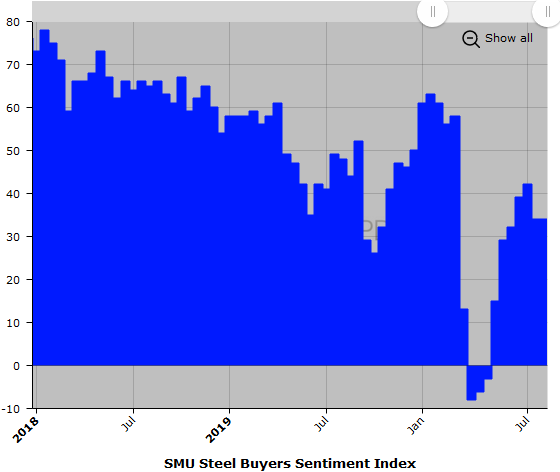
Future Sentiment
Likewise, SMU’s Future Sentiment Index was unchanged at a reading of +38. That’s down from +52 in the week of July 9. Future Sentiment hit a recent low of +10 in early April shortly after the pandemic took hold. At this time last year, Future Sentiment registered +48.
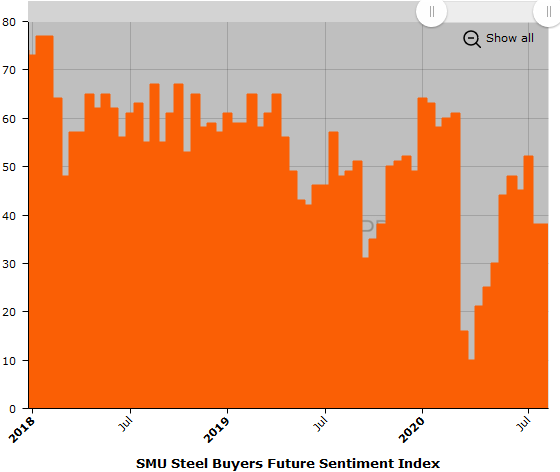
Three-Month Moving Averages
Results from SMU’s market trends questionnaire are posted as both single data points and as three-month moving averages (3MMAs) to smooth out the trend. Both Current and Future Sentiment measured as 3MMAs continue to trend upward. The Current Sentiment 3MMA increased to +35.00, up from the recent low of +6.67 in late May. The Future Sentiment 3MMA rose to +44.17 from the May low of +24.33.
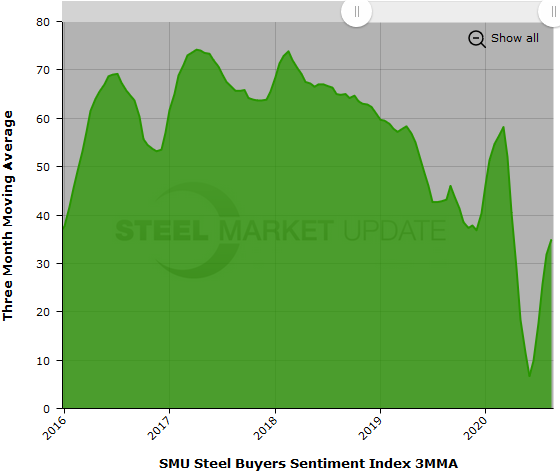
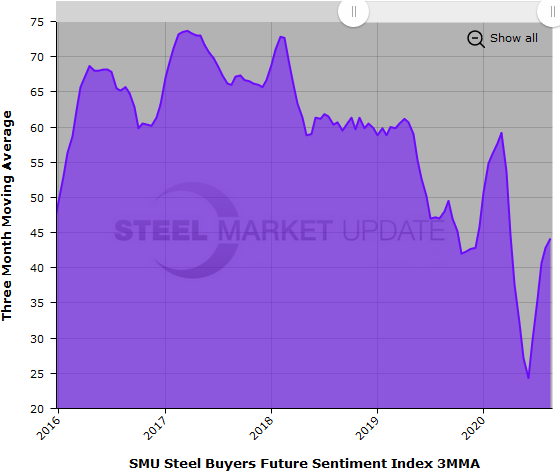
The chart below shows the hint of leveling in the recent uptrend in the annual rate of change in the three-month moving averages for both Current and Future Sentiment.
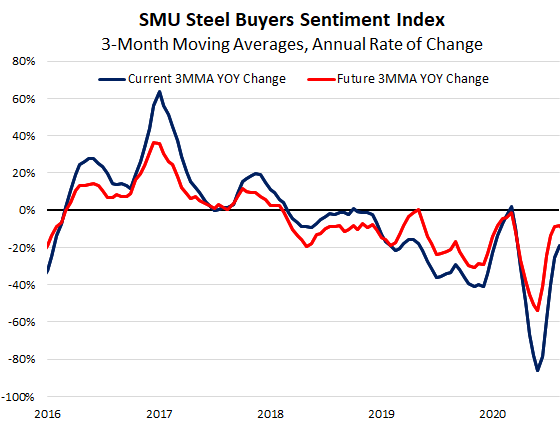
What Respondents Had to Say
“There are still too many unknowns.”
“COVID strikes again. A few customers are limiting operations or closing down again due to outbreaks in their plants. Just as things started getting back to normal.”
“It’s difficult to make any accurate predictions due to the fluctuation of the virus in different areas of the U.S.”
“No long-term planning, uncertainty being the reason.”
“Commercial business is lagging. Before we can see a dependable recovery, commercial construction needs to rebound.”
“We need a commitment from users to buy additional steel.”
“With fall coming, we will have to deal with COVID and the flu. We will have to treat symptoms as COVID concerns first and foremost. Demand is already starting to suffer.”
“I fear more of the same for the balance of the year.”
About the SMU Steel Buyers Sentiment Index
SMU Steel Buyers Sentiment Index is a measurement of the current attitude of buyers and sellers of flat rolled steel products in North America regarding how they feel about their company’s opportunity for success in today’s market. It is a proprietary product developed by Steel Market Update for the North American steel industry.
Positive readings will run from +10 to +100 and the arrow will point to the righthand side of the meter located on the Home Page of our website indicating a positive or optimistic sentiment. Negative readings will run from -10 to -100 and the arrow will point to the lefthand side of the meter on our website indicating negative or pessimistic sentiment. A reading of “0” (+/- 10) indicates a neutral sentiment (or slightly optimistic or pessimistic), which is most likely an indicator of a shift occurring in the marketplace.
Readings are developed through Steel Market Update market surveys that are conducted twice per month. We display the index reading on a meter on the Home Page of our website for all to see. Currently, we send invitations to participate in our survey to more than 600 North American companies. Our normal response rate is 100-150 companies; approximately 40 percent are manufacturers, 45 percent are service centers/distributors, and 15 percent are steel mills, trading companies or toll processors involved in the steel business. Click here to view an interactive graphic of the SMU Steel Buyers Sentiment Index or the SMU Future Steel Buyers Sentiment Index.

Tim Triplett
Read more from Tim TriplettLatest in SMU Data and Models

SMU market survey results now available
The latest SMU market survey results are now available on our website to all premium members. After logging in at steelmarketupdate.com, visit the pricing and analysis tab and look under the “survey results” section for “latest survey results.” Historical survey results are also available under that selection. If you need help accessing the survey results, or if […]

SMU survey: Buyers’ Sentiment finishes April on the upswing
SMU’s Steel Buyers’ Sentiment Indices both rose this week to reach some of the highest levels seen this year.

SMU survey: HR, plate lead times slip as CR extends
Hot-rolled coil and plate lead times contracted this week, with most other products remaining flat, according to SMU's most recent survey data. Cold-rolled products, however, saw lead times extend 0.1 weeks to an average of 7.5 weeks vs. two weeks earlier. Hot rolled and plate lead times both contracted 0.3 weeks from our last market check.

SMU survey: Sheet buyers find mills more willing to negotiate spot prices
Sheet steel buyers said mills are more willing to talk price on spot orders, according to our most recent survey data.

Steelmaking raw material prices mixed in April
Prices of steelmaking raw materials have moved in different directions over the last 30 days, according to Steel Market Update’s latest analysis.
